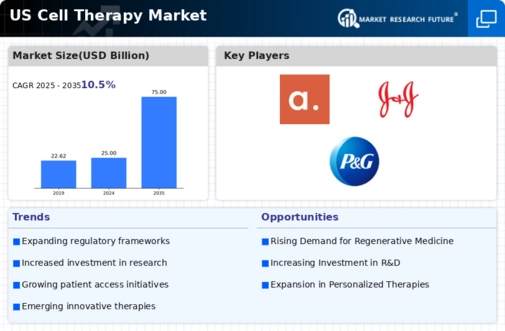Supportive Reimbursement Policies
Supportive reimbursement policies are emerging as a crucial driver for the cell therapy market. As more cell therapies gain approval, insurance companies and government programs are beginning to recognize their value and are adjusting reimbursement frameworks accordingly. This shift is essential for ensuring patient access to these innovative treatments, which can often be costly. In 2025, it is anticipated that reimbursement rates for cell therapies will improve, making them more accessible to a broader patient population. This trend is likely to encourage healthcare providers to adopt cell therapies in their practices, thereby stimulating growth in the cell therapy market. Enhanced reimbursement policies could ultimately lead to increased patient enrollment in clinical trials and expanded treatment options.
Growing Patient Awareness and Demand
Patient awareness regarding the benefits of cell therapies is on the rise, significantly impacting the cell therapy market. As patients become more informed about their treatment options, they are increasingly seeking advanced therapies that offer better outcomes. Educational initiatives and advocacy groups are playing a vital role in disseminating information about the potential of cell therapies, particularly in treating previously hard-to-manage conditions. This heightened awareness is likely to drive demand for cell therapies, as patients actively pursue these innovative treatment options. Consequently, healthcare providers are responding to this demand by incorporating cell therapies into their treatment protocols, further propelling the growth of the cell therapy market.
Rising Prevalence of Chronic Diseases
The increasing incidence of chronic diseases in the US is a pivotal driver for the cell therapy market. Conditions such as cancer, diabetes, and cardiovascular diseases are becoming more prevalent, necessitating innovative treatment options. According to the CDC, chronic diseases account for 7 of the 10 leading causes of death in the US, highlighting the urgent need for effective therapies. Cell therapy offers potential solutions by targeting the underlying causes of these diseases, thereby improving patient outcomes. The market is projected to grow as healthcare providers seek advanced therapies to manage these conditions. As a result, the cell therapy market is likely to experience substantial growth, driven by the demand for novel treatment modalities that address chronic health issues.
Technological Innovations in Cell Therapy
Technological advancements are significantly influencing the cell therapy market. Innovations in gene editing, such as CRISPR, and improvements in cell manufacturing processes are enhancing the efficacy and safety of cell therapies. These technologies enable the development of more precise and effective treatments, which are crucial for addressing complex diseases. The market is expected to expand as these innovations lead to the introduction of new therapies that can be tailored to individual patient needs. Furthermore, the integration of artificial intelligence in research and development processes is streamlining the discovery of new cell therapies, potentially accelerating their time to market. This technological evolution is likely to bolster the cell therapy market, making it a dynamic and rapidly evolving sector.
Increased Investment in Research and Development
Investment in research and development (R&D) is a critical driver for the cell therapy market. The US government and private sector are allocating substantial funds to advance cell therapy research, recognizing its potential to revolutionize treatment paradigms. In 2025, R&D spending in the biopharmaceutical sector is projected to reach approximately $100 billion, with a significant portion directed towards cell and gene therapies. This influx of capital is fostering innovation and facilitating clinical trials, which are essential for bringing new therapies to market. As more therapies receive regulatory approval, the cell therapy market is likely to witness accelerated growth, driven by the successful commercialization of novel treatments that emerge from this robust R&D environment.














Leave a Comment